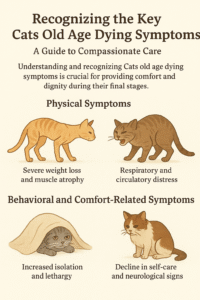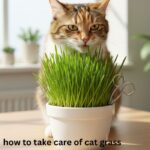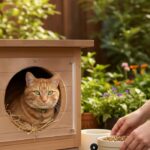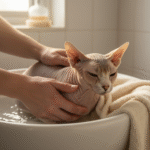Understanding and recognizing Cats old age dying symptoms is crucial for providing comfort and dignity during their final stages. Learn the key physical and behavioral changes to watch for in your senior feline friend.
Recognizing the Key Cats Old Age Dying Symptoms: A Guide to Compassionate Care
The journey of a cat’s life brings immeasurable joy, but as our beloved felines enter their senior years, recognizing the signs of their gradual decline becomes a compassionate responsibility. While a veterinarian is the only one who can provide a definitive prognosis, understanding the common Cats old age dying symptoms allows owners to make informed decisions about comfort, palliative care, and ultimately, a peaceful passing.
This guide explores the key physical and behavioral indicators of a cat nearing the end of its life, helping you navigate this tender time with love and support.
Core Physical Cats Old Age Dying Symptoms
Physical changes are often the most noticeable Cats old age dying symptoms. These signs reflect the body’s systems beginning to shut down or struggling to maintain normal function.
Severe Weight Loss and Muscle Atrophy
One of the most concerning signs is profound physical decline. This involves:
- Extreme weight loss and muscle weakness: A loss of appetite, coupled with the body’s reduced ability to digest and absorb nutrients, leads to a noticeable decline in muscle mass, particularly over the spine and hips.
- Loss of appetite or refusal to eat: A cat that completely refuses food and water for an extended period is a critical indicator of serious health decline and is a primary consideration when evaluating quality of life.
Respiratory and Circulatory Distress
As vital organs struggle, breathing and temperature regulation can be severely affected:
- Difficulty breathing or irregular breathing patterns: This can manifest as shallow, labored, or irregular breaths, and may be a sign of fluid in the lungs or organ failure.
- Cold body temperature, especially in paws and ears: A drop in the cat’s normal body temperature (hypothermia) is a sign of declining circulation and is often present in the final stages.
Gastrointestinal and Mobility Issues
A breakdown in normal body processes affects movement and elimination:
- Changes in litter box habits (incontinence or no urination/defecation): Accidents outside the litter box (incontinence) or a complete lack of urination or defecation can indicate muscle control loss or severe dehydration/organ failure.
- Vomiting or diarrhea becoming frequent: Persistent digestive distress can lead to rapid dehydration and loss of essential nutrients, contributing to the list of serious Cats old age dying symptoms.
- Loss of coordination and trouble walking: Weakness and muscle atrophy make movement difficult. Your cat may stumble, have difficulty jumping, or be unable to stand for long periods.
Behavioral and Comfort-Related Cats Old Age Dying Symptoms
Behavioral changes are often just as significant as physical ones, revealing a cat’s instinct to isolate or its decreased cognitive function and interest in the world.
Increased Isolation and Lethargy
A cat’s natural instincts often guide its final days:
- Hiding away or isolating from family members: Many cats instinctively seek a quiet, secluded place when they feel vulnerable or unwell. This is a common and natural response.
- Increased sleeping and lack of interest in surroundings: While senior cats sleep a lot, a dying cat will exhibit extreme lethargy, spending almost all its time sleeping and showing little to no interest in interactions, toys, or events that once stimulated them.
- Unresponsiveness or lack of energy: The cat may appear detached, difficult to wake, and unresponsive to familiar voices or sounds. This further highlights the severity of the Cats old age dying symptoms.
Decline in Self-Care and Neurological Signs
A cat’s meticulous nature often disappears when it is critically ill:
- Poor grooming habits and messy fur: A lack of energy and flexibility means the cat stops its rigorous self-grooming, resulting in a dull, matted, or unkempt coat.
- Seizures or unusual twitching in final stages: In the very end stages, neurological events like seizures or muscle tremors may occur, which is a signal of the body’s final shut down.
Compassion and Quality of Life Assessment
Witnessing these Cats old age dying symptoms is heartbreaking, but it provides a critical opportunity to ensure a comfortable and dignified farewell. The best approach is to consult with your veterinarian as soon as you observe a combination of these signs.
Your vet can help you perform a “Quality of Life” assessment, considering factors like pain management, appetite, hydration, and overall happiness. Providing soft bedding, keeping food and water bowls close by, and offering quiet, loving presence can make the cat’s final time peaceful.
It is a true act of love to recognize when the discomfort and suffering outweigh the joy in your cat’s life, and to choose the most humane path forward. Understanding Cats old age dying symptoms empowers you to be your feline friend’s most compassionate advocate until the very end.
Frequently Asked Questions (FAQs)
1. How do I know if my cat is just aging or showing Cats old age dying symptoms?
Many signs, like increased sleeping or mild stiffness, are normal in senior cats. However, true Cats old age dying symptoms typically involve a rapid and severe decline in core functions. Look for a combination of extreme weight loss, a complete refusal to eat or drink, significant difficulty breathing, and total withdrawal or unresponsiveness. If multiple critical symptoms (such as extreme lethargy, refusal to eat, and labored breathing) occur together, it strongly suggests the end-of-life process.
2. How long does a cat typically live after showing these severe symptoms?
It is highly variable, ranging from a few hours to several days, or even a couple of weeks, depending on the underlying condition and the severity of the Cats old age dying symptoms. A cat that has completely stopped eating and drinking, is extremely cold, and is unresponsive is likely in the final hours. For chronic conditions, decline can be slow, but a sudden onset of symptoms like labored breathing or seizures indicates a rapid deterioration.
3. Can my cat be in pain even if it’s not crying or meowing?
Yes. Cats are masters at hiding pain due to their evolutionary instinct as both predator and prey. Signs of pain are often subtle and include a hunched posture, resistance to being touched, hiding, reluctance to move, heavy or irregular breathing, and an inability to get comfortable. If you notice any of the severe Cats old age dying symptoms, pain management should be discussed with your vet immediately.
4. Should I force my cat to eat or drink when they show these end-of-life symptoms?
Generally, no. In the very final stages, a cat’s body is shutting down and its digestive system cannot process food or water effectively. Forcing food or liquids can cause distress or even lead to aspiration. The kindest thing to do is to offer easy-to-access, gentle options like warm tuna juice or bone broth near their resting place, but do not force it. Focus on keeping them warm, comfortable, and feeling loved.











